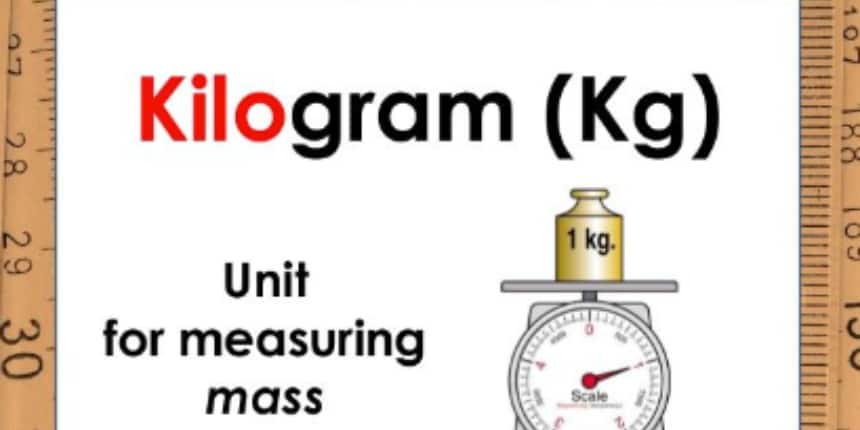KGF Unit Full Form
In Physics, every unit can be related to one another through unit conversions without violating the laws of nature or Physics. As we know, the kilogram is the SI unit of mass and Newton is the SI unit of force. From Newton’s second law of motion, we can say that kilogram and Newton are directly proportional, which means that any change in the Kg unit of mass will result in a change in the Newton unit of force, while acceleration remains constant. The full form of kgf is kilogram-force which is a non-standard unit of force and it is classified as a unit that is not accepted by the SI units system.
This Story also Contains
- History
- Gravitational Units of Force: kgf & gf
- Relation Between Kilogram-force (kgf) And Newton (N)

History
The gram-force and the kilogram-force were never clearly defined units until 1901, when the CGPM (General Conference on Weights and Measures) adopted a standard acceleration due to gravity of
\[9.80665{\text{ m/}}{{\text{s}}^2}\] ![]() for this purpose, although they had been used before in force measurements of low accuracy. Even then, the proposal to define the kilogram-force as the standard unit of force was explicitly rejected. Instead, the unit Newton was proposed in 1913 and adopted in 1948. The kilogram-force was never part of the International System of Units (SI), which was adopted in 1960.
for this purpose, although they had been used before in force measurements of low accuracy. Even then, the proposal to define the kilogram-force as the standard unit of force was explicitly rejected. Instead, the unit Newton was proposed in 1913 and adopted in 1948. The kilogram-force was never part of the International System of Units (SI), which was adopted in 1960.
Before that, this unit was widely used in much of the world. It is still used for some purposes, such as for the tension of bicycle spokes, for informal indications of pressure in kilograms per square centimetre
( \[1{\text{ kg/c}}{{\text{m}}^2}\] ![]() ), which corresponds to the technical atmosphere pressure and is very close to 1 bar and the standard atmosphere (atm), for the draw weight of bows in archery, for the strength of binding wire in gram-force, and to define "metric horsepower" as 75 metre-kiloponds per second.
), which corresponds to the technical atmosphere pressure and is very close to 1 bar and the standard atmosphere (atm), for the draw weight of bows in archery, for the strength of binding wire in gram-force, and to define "metric horsepower" as 75 metre-kiloponds per second.
Different approaches to metric units of mass and force or weight
Base | Mass | Weight | Force | ||
2nd law of motion | \[m\; = \;F/a\] | \[F\; = \;W\; \times {\text{ }}a/g\] | F = ma | ||
SYSTEM | GM | M | CGS | MTS | SI |
Acceleration (a) | m/{s^2} | m/{s^2} | m/{s^2} | m/{s^2} | |
Mass (m) | hyl | kilogram | gram | tonne | kilogram |
Force (F), | kilopond | kilopond | dyne | sthène | newton |
weight (W) | |||||
Pressure (p) | technical atmosphere | barye | pieze | pascal | |
Gravitational Units of Force: kgf & gf
Kgf and gf both are gravitational units of force. Kgf (kilogram-force) is equal to a mass of one kilogram multiplied by the standard acceleration due to gravity on Earth’s surface which is \[9.80665{\text{m/}}{{\text{s}}^2}\] ![]()
So, one kilogram-force is generally equal to 9.80665 N. Similarly, a gram-force is 9.80665 mN and a milligram-force is \[9.80665{\text{ }}\mu {\text{N}}\] ![]()
Relation Between Kilogram-force (kgf) And Newton (N)
1 kgf is the weight of a mass of 1 kg at a place where acceleration due to gravity is
\[g = 9.80665{\text{ m/}}{{\text{s}}^2}\] 
Now, we have
W = mg \\
\Rightarrow 1kgf = 1kg \times 9.80665{\text{ m}}{\text{.}}{{\text{s}}^{ - 2}}
![]()
Therefore,
\Rightarrow 9.80665{\text{ }}kg.{\text{m}}{\text{.}}{{\text{s}}^{ - 2}} ![]()
So now we get,
1kgf = 9.80665N ![]()
Frequently Asked Questions (FAQs)
Newtons and kgf are both units used to measure force.
Since 1N=0.101972kgf ![]()
So, we can say that 5N=5\times 0.101972=0.509858kgf ![]()
To convert a kgf measurement to a gf measurement, we need to multiply the force by the conversion ratio.
Since 1kgf=1000gf ![]()
So, we can say that one kilogram-force (kgf) is equal to 1000 gram-force (gf).
A kilogram is a metric unit for calculating mass and a pound is an imperial unit for calculating mass. A kilogram is a unit solely for the measurement of mass and pounds can express both mass and force. One kilogram is equal to 2.204 pounds while one pound is equal to 0.453 kg. These are the main differences between kilogram and pound.
The force exerted by the Earth’s gravitation on an object of mass 1 kg is called 1 kgf. F=ma ![]() (Newton’s second law of motion)
(Newton’s second law of motion)
F=1kg\times 9.807\frac{m}{s^{2}} 
So, we can write, F=9.807N ![]()
So, we can say that 1kgf=9.807N ![]()
No, 1 kgf is not equal to 1 kg. 1 kgf is the weight of a kilogram under standard gravity. As a result, one kilogram-force equals 9.80665 Newtons.
Since 1kgf=1000gf ![]()
Hence, it is clear that 1 kgf is equal to 1000 gf (gram-force).